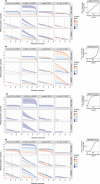A Bayesian network approach to trophic metacommunities shows that habitat loss accelerates top species extinctions
- PMID: 32981202
- PMCID: PMC7702078
- DOI: 10.1111/ele.13607
A Bayesian network approach to trophic metacommunities shows that habitat loss accelerates top species extinctions
Abstract
We develop a novel approach to analyse trophic metacommunities, which allows us to explore how progressive habitat loss affects food webs. Our method combines classic metapopulation models on fragmented landscapes with a Bayesian network representation of trophic interactions for calculating local extinction rates. This means that we can repurpose known results from classic metapopulation theory for trophic metacommunities, such as ranking the habitat patches of the landscape with respect to their importance to the persistence of the metacommunity as a whole. We use this to study the effects of habitat loss, both on model communities and the plant-mammal Serengeti food web dataset as a case study. Combining straightforward parameterisability with computational efficiency, our method permits the analysis of species-rich food webs over large landscapes, with hundreds or even thousands of species and habitat patches, while still retaining much of the flexibility of explicit dynamical models.
Keywords: Bayesian network; habitat loss; metacommunity; spatial food web.
© 2020 The Authors. Ecology Letters published by John Wiley & Sons Ltd.
Figures




References
-
- Allesina, S. & Pascual, M. (2009). Food web models: a plea for groups. Ecol. Lett., 12, 652–662. - PubMed
-
- Årevall, J. , Early, R. , Estrada, A. , Wennergren, U. & Eklöf, A. (2018). Conditions for successful range shifts under climate change: The role of species dispersal and landscape configuration. Divers. Distrib., 24, 1598–1611.
-
- Beisner, B.E. , Peres‐Neto, P.R. , Lindström, E.S. , Barnett, A. & Longhi, M.L. (2006). The role of environmental and spatial processes in structuring lake communities from bacteria to fish. Ecology, 87, 2985–2991. - PubMed
MeSH terms
Grants and funding
LinkOut - more resources
Full Text Sources
Other Literature Sources

